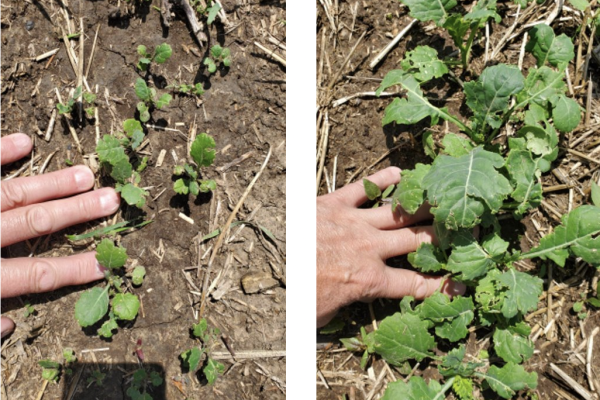Healthy soil is the foundation of productive, sustainable agriculture. Managing for soil health allows farmers to work with the land – not against – to reduce erosion, maximize water infiltration, improve nutrient cycling, save money on inputs, and ultimately improve the resiliency of their working land. With a three-part series, Replenish Nutrients hopes to break down barriers to understanding and implementing forms of regenerative agriculture. For more, read our second article, Regenerative Agriculture: Profitability, productivity, and sustainability, where invited cattle rancher and ag-tech enthusiast, Jason Bradley, to take us on a deep dive into why farmers should care about soil health and usable best practices.
There’s nothing new about regenerative agriculture. It’s as old as farming itself. The earliest farmers shaped and tended their fields with care and precision, knowing that they must tend to the soil first while crops were selected based on need. Nutrients were cycled back onto the land through manure, compost, and plant matter. It was a matter of life and death. Get this wrong, and people could starve.
The industrial revolution brought an influx of new technology into agriculture. Machinery replaced man in tasks like sowing fields and harvesting crops. With this the producers focus changed to feeding the plant to achieve greater yields and attention to soil health and tending to the microbiome was forgotten about. And with it, the ancient traditional methods were sidelined.
But history has a habit of repeating itself. You need only to look at your shopping cart. The term “regenerative” frequently appears on produce labels. And while you could mistake this as a yet-another marketing buzzword, there’s substance beyond the hype.
So what is it?
Not everyone agrees on what regenerative agriculture means. And while you can quibble about specific details, one thing remains constant: regenerative agriculture practices rebuild soil organic matter and restore degraded soil biodiversity.
While these farming and grazing practices can ultimately reverse climate change, the best – and more immediate – benefits are those that directly help farmers.
Regenerative agriculture focuses on topsoil regeneration, biodiversity, water cycle, and enhancing ecosystems to increase climate change resilience. All while strengthening the health and vitality of farm soil.
That broad definition includes dozens of practices. However, the intent is the same: ensuring the food supply doesn’t come at the cost of the soil that produces it.
Why now?
Consumer behavior and awareness of environmental concerns are driving demand for produce created under regenerative conditions. This comes alongside other growing trends, like farm-to-table purchasing habits and greater adoption of vegan practices. This is especially true for younger adults and teenagers, who are overwhelmingly concerned about climate change.
Responding to this demand are giants like General Mills which has committed to using regenerative practices on over one million acres of farmland, by the end of the decade. These companies are backing this up by boots on the ground expertise as they work directly with farmers to lead this change. And while you can dismiss this as a PR tactic, it nonetheless will have some impact on raising the farming standards.
Why does soil health matter?
Arable land is a finite commodity. There’s only so much of it. Ensuring soil health is a necessary step in protecting the sustainability of this scarce resource. History tells us what happens when we get this wrong.
For a recent history of why healthy soil is needed, you only need to look back at the 1930s. That’s when the largest agricultural disaster in American history happened: The dust bowl. When farmers tilled large tracts of land for agriculture across the great plains, they left the soil exposed. That led to mass erosion of topsoil, and by the end of 1934, it caused roughly 100 million acres of land to be permanently damaged. Fortunately, farming practices are changing, much more in line with the ancient way of doing things. Mainly no till practices and crop rotation are being used to preserve and replace nutrients in the soil and water preservation through a significant increase in biomaterials.
But higher yields are more profitable
This is the most common argument against this type of farming. Modern farms are producing higher yields per acre than at any time in human history. That leads to more money in the farmers’ pockets, right? Not exactly.
An oversupply of foodstuffs leads to sinking prices. That means that a farmer needs to produce even more per acre to make money. If you look at the glut of soybeans in the US right now, you can understand some of the market effects of higher yields and agricultural trade. While regenerative farming doesn’t always lead to increased yields, it’s important to understand that these sustainable processes can usher in higher profitability. Furthermore, farmers who have adopted these methods can often achieve comparable yield results. By producing more profitable crops, they’re able to be more sustainable in the long-run. A recent study found that regenerative farms are actually 78 percent more profitable than those with only conventional practices.
There’s also the added benefit of reducing input costs per acre. Over time, regenerative agricultural systems require less external inputs, primarily in the form of seed and fertilizer. Increasing soil organic matter decreases the need for external fertilizer by ensuring more natural nutrients remain in the soil. But it isn’t just fertilizer. Researchers have found that these practices increase biodiversity, which can have a halting effect on harmful pests, which leads to stronger, more resilient crops and less investment from the farmer.
Water is expensive
An often-touted claim in regards to this type of farming is that “each one percent increase in soil organic matter helps soil hold 20,000 gallons more water per acre.” But is that true?
Experts say yes. They even point to a simple-ish math equation to prove the point. So if a farmer can reduce their fertilizer costs, water costs and make more profit per acre, it seems like a no-brainer. The cherry on top, though, is that the US government is also getting on-board. They’re subsidising farmers who are willing to switch over to regenerative agriculture. Similar to electric vehicle subsidies to increase adoption, the US government believes that this type of farming is the future of food production.
Regenerative-Ag is embraced by more than just hippies
Well respected farming and agricultural organizations are embracing regenerative agriculture practices as well.
Just this month, Cargill announced a 10-year initiative encouraging farmers to adopt regenerative agriculture practices across 10 million acres of North American farmland. Land O’Lakes instituted its SUSTAIN program to advance and connect stewardship efforts throughout the food system with scale as well as its efforts to conserve soil, air, and water. Recently, roughly twenty companies – including Danone, Kellogg, and Nestlé – launched the One Planet Business for Biodiversity (OP2B). The coalition is focused on advancing regenerative agriculture, rebuilding biodiversity, and eliminating deforestation.
Still others – like Panorama Organic Grass-Fed Meats network – understand that soil health extends beyond plant-based farms. With one million acres of organic land, Panorama’s regenerative and organic ranching practices help restore land, soil, and water – as well as wildlife – critical to “preserving a legacy founded by ranchers for ranchers.”
At Replenish Nutrients, we understand that soil organic matter (SOM) affects everything from soil structure, function, and moisture-holding capacity to nutrient cycles and bioavailability. Soils with high soil organic matter content display better water storage capacity and higher water infiltration rates, making crops more drought-resistant. Advanced organic fertilizer formulations, like ours, can boost nutrient efficiency and improve soil biology by providing a home for the micronutrients in the soil.
So while regenerative agriculture may seem overly buzz-worthy, there is proven substance – and support – behind the hype.



